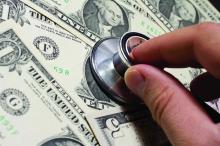Nonalcoholic fatty liver disease (NAFLD) is estimated to affect over 64 million people each year in the United States, leading to medical costs of more than $100 billion, according to a new analysis.
Using a steady-state prevalence model, Zobair M. Younossi, MD, MPH, from the Center for Liver Diseases at Inova Fairfax (Va.) Hospital, and his coauthors, sought to estimate the prevalence and economic burden of NAFLD in the United States, Germany, France, Italy, and the United Kingdom.
“In the context of growing clinical and quality-of-life burden of NAFLD, the economic burden of this important liver disease for the United States and Europe is likely to increase,” Dr. Younossi and his colleagues wrote in a paper published online Sept. 26 in Hepatology. “Given the epidemic of NAFLD, understanding the full burden of NAFLD will help providers, payers, and policy makers to develop strategies to identify high-risk patients with NAFLD and to implement a multipronged public health policy to deal with this important chronic liver disease.”Their models, which were calibrated against real-world prevalence rates, predicted an estimated 58 million prevalent cases and 12 million new cases of NAFLD each year in the US alone (Hepatology. 2016 Sep 26. doi: 10.1002/hep.28785).
The models also incorporated the transition of patients between nine health states, from NAFLD through nonalcoholic steatohepatitis (NASH) to NASH fibrosis, compensated and decompensated cirrhosis, hepatocellular carcinoma, liver transplantation, posttransplant, and death.
They forecast an overall prevalence of 64 million cases of NAFLD annually in the United States, which includes more than 5.5 million prevalent cases – and 600,000 incident cases – of NASH. The number of incident cases of NAFLD were highest in the patients aged 45-64 years, while the incident cases of NASH and hepatocellular carcinoma peaked in the patients aged 65 years and older.
The results were proportionally similar for the four European countries, although when it came to the analysis of economic burden, researchers found the direct costs of NAFLD were much higher in the United States.
Overall, NAFLD costs $103 billion each year in the United States, compared with EU 27.7 billion in Germany, France, and Italy, and GBP 5.24 billion in the United Kingdom. The authors attributed these greater costs to a larger population, as well as higher costs of managing disease-related complications.
“However, if we assume the annual rate of increase in the costs due to NAFLD to parallel the annual growth in the prevalence of obesity in the United States since 1994, the expected 10-year burden of NAFLD could increase substantially – to an estimated $1.005 trillion in the United States and EU334 billion in the Europe-4,” they noted.
Total costs were highest in the group aged 45-65 years, but per-patient costs were highest in the group aged 65 years and older, which the authors said reflected the higher proportion of these patients in more advanced stages of disease.
The authors also argued that these cost estimates do not take into account the societal costs related to the loss of quality years of life to NAFLD and its complications.
“By assigning a monetary value to societal costs and adding these to the annual direct cost of NAFLD for the United States and the Europe-4, the total annual cost of NAFLD can be estimated at $292.19 billion and EU227.84 billion, respectively,” they wrote. “Furthermore, these cost calculations do not take into account other indirect costs of NAFLD, which are related to work-productivity loss and its economic impact.”
The study was partly funded by Gilead Sciences. Four authors declared consultancies and advisory positions for the pharmaceutical industry, including Gilead.



